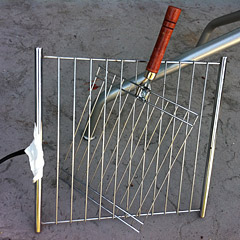Posted: July 17th, 2015 | Author: Nathan | Filed under: music, sound design
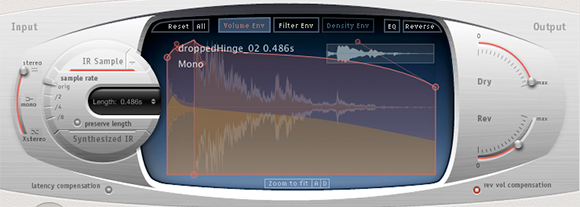
Sure, it’s fun to use long, non-reverb sounds as impulse responses…but what about short, percussive ones?
Convolution reverbs have been a staple of audio post-production for a good while, but like most tools of any type, I prefer to force tools into unintentional uses.
While I am absolutely not the first person to use something other than an actual spatial, reverb-oriented impulse response – bowed cymbals are amazing impulse responses, by the way – I hadn’t really looked into using very short, percussive impulse responses until recently. I mean, it’s usually short percussive sounds you’re processing through the convolution reverb. I found that it can add an overtone to a sound that can be pretty unique. Try it sometime!
(Coincidentally, today Diego Stocco’s is promoting his excellent Rhythmic Convolutions, a whole collection of impulse responses meant for just these creative purposes. Go check it out!)
Today’s sample is in three parts. First, a very bland percussion track. Then, the sound of a rusty hinge dropped from about one foot onto a rubber mat, recorded with my trusty Sony PCM-D50 field recorder. Then, the same percussion track through Logic Pro’s Space Designer (Altiverb or any other convolution reverb will do, of course) using the dropped hinge sound as an impulse response. It adds a sort of distorted gated reverb, adding some grit, clank, and muscle to an otherwise pretty weak sound.
[soundcloud url=”https://api.soundcloud.com/tracks/214427372″ params=”color=ff5500&auto_play=false&hide_related=false&show_comments=true&show_user=true&show_reposts=false” width=”100%” height=”166″ iframe=”true” /]
Tags: convolution, digital audio, reverb, software, sound design | No Comments »
Posted: April 2nd, 2014 | Author: Nathan | Filed under: field recording, gear, sound design
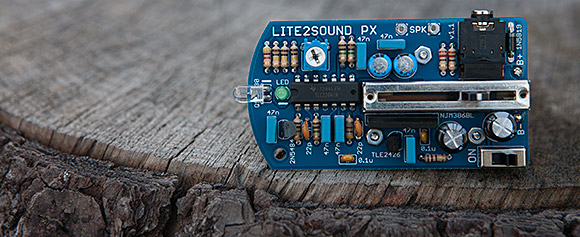
Rare Waves’ Lite2Sound PX, by Eric Archer: A photonic microphone!
I’ve previously written about the heavily-built, wickedly cool Grendel Drone Commander synth from Eric Archer. I check his site, Rare Waves, from time to time for new handmade electronic toys, and I was really intrigued by his newer Lite2Sound PX unit. This small device, in Eric’s words, “extracts audio from ambient light.” It’s a photodiode amplifier. Or a photosensitive microphone. Point it at light, it makes sound. It runs off a 9-volt battery, has a volume control, and a headphone jack. Simple, exciting, and a whole new world of sonic insanity. You can buy them as kits or, as I did, fully assembled.
Sounds pretty straightforward. If you just point it at bright, broad light sources, it’s kind of disappointing. It’s when you start listening to artificial lights in otherwise dim environments that some serious magic starts to happen. My experiments were conducted in and around high tech computer equipment, running an 1/8″ mini jack from the headphone output into my Sony PCM -D50 recorder.
Lights inside of PCs, modulated by fans…and further modulated by speaker grills as I passed the Lite2Sound from side to side. Ethernet network activity lights. Server disk access indicator lights. A close up of the power button of an XBox 360 while booting up. Pulsing lights of devices in standby mode. Halogen lamps behind spinning desk fans.
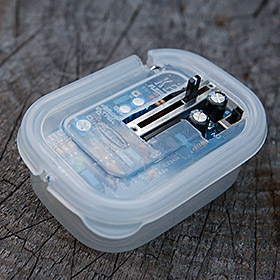
Lightly armored for future fieldwork!
The resulting sounds were astounding in their range: Static, glitches, distorted synth pads, pure sinewave tones, sawtooth-like tones, and much more. You can’t control it, really. It’s a tool of discovery, and its very nature encourages constant experimentation. It was so small and so perfectly complemented a handheld field recorder, I just wanted to take it everywhere and point it at everything! It imparted the same joy as when you start recording with contact microphones, or hydrophones: A new way to listen to the world around you. The more I used the Lite2Sound, I put it in a small plastic container (hacked with an XActo knife for access to controls and the headphone jack) in order to keep the components better protected.
Lite2Sound is a pretty narrowly-focused device and how useful it is to you depends on your taste for the unpredictable. Me, I adore this thing. Hell, I bought two (for future stereo photo-phonic insanity). It encourages constant experimentation, weighs nothing, and I can see using its output in both sound design and musical contexts. Eric Archer nails it again with an odd concept and a rock-solid, focused execution that results in a toy that just begs to be played with.
[soundcloud url=”https://api.soundcloud.com/tracks/139812053″ params=”color=ff5500&auto_play=false&hide_related=false&show_artwork=false” width=”100%” height=”166″ iframe=”true” /]
Tags: audio equipment, digital audio, field recording, sound design, sound effects | 3 Comments »
Posted: October 13th, 2011 | Author: Nathan | Filed under: found sound objects, sound design
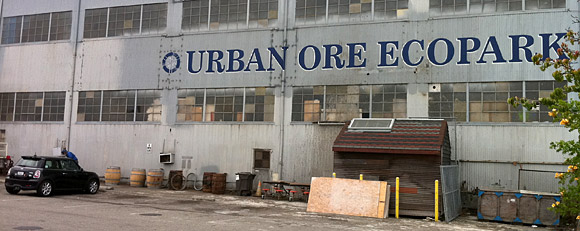
My mecca on a foggy morning: Urban Ore!
I went to the granddaddy of thrift stores recently, so much so that it’s more of a glorified junk store…but oh, what glorious junk. I’m talking about Urban Ore in Berkeley, California. Sometimes I’m self-conscious shopping for things by ear, picking up random things and just listening to them, but at Urban Ore – heck, Berkeley in general – I can ear-shop in peace.
I was in a metallic mood, so I filled a bag with things that squeak, resonate, creak, clank, and sproing. Based on the dronetastic results of striking wire shelving last year, I picked up a few thin-wire metal grills that had sonic promise, among other things that will surely find their way to this blog later this fall and winter.
For the grills, I decided to trot out my much-neglected piezo contact microphones. The resonant notes were so subtle that it seemed like the best way to capture the sound at a reasonable volume. I plucked them, struck them, and played them with a cello bow. The magic happened, though, when I realized one was easily played with a bow and the other was not, so I stuck the bowable one inside of the other, and played away, causing both of them to resonate when played appropriately.
The results were like ultra-low-fi bastardizations of stringed instruments played in horror movies, and I just loved the character. The rawness of hearing the actual hairs of the bow on the metal, in my opinion, lends to the eerie charm.
[soundcloud url=”http://api.soundcloud.com/tracks/25407627″ params=”show_comments=true&auto_play=false&color=ee0000″ width=”100%” height=”81″ ]
[Contact microphone into Sound Devices 702 recorder]
Tags: creepy, digital audio, eerie, found object, groaning, horror, metal, resonance, sound design, sound effects | No Comments »
Posted: July 4th, 2011 | Author: Nathan | Filed under: field recording, music
Hot days in the city can force people into the street, where it can be cooler than in their apartments or homes. I usually reach for my field recorder when the mercury rises, which I hang out of a third-floor office window.
This is a recording (longer than most I usually post) that features everything I like in an urban ambiences: Sirens. Heavy trucks. Busses. Voices in different languages. Motorcycles. Car horns. Murmuring and footsteps.
And a guy noodling around on the trumpet.
[soundcloud url=”http://api.soundcloud.com/tracks/18303006″ params=”show_comments=true&auto_play=false&color=ee0000″ width=”100%” height=”81″ ]
[Sony PCM-D50 recorder, capsules at 120°]
Tags: ambience, digital audio, field recording, San Francisco, urban, vehicle | No Comments »
Posted: June 5th, 2011 | Author: Nathan | Filed under: field recording, nature recording

Thus quoth the raven, "Press record, idiot!" (This picture was taken years ago in Oakland, CA, not where today's sound was recorded.)
[One in a series of posts from my spring 2011 trip to the southern California desert.]
I love ravens. Not because I’m all Mr. Gothy McLordbyron, but because they’re big, majestic, smart as hell, and have gravelly voices. Like crows, but drunker. They’re the Tom Waits of the bird world.
Ravens aren’t exactly rare, and perhaps because of this, they’re hard to record in the wild. They can be anywhere: Urban areas, tops of trees, windswept hills…but by the time I show up with a recorder, they’re either deciding to be quiet or are surrounded by traffic noise, intense winds, other birds, or even people. I’ve had the darnedest time capturing one cleanly.
Thankfully, the ravens of Joshua Tree National Park are pretty fearless…well, they’re also always looking for snacks, and have learned that people can be a good source for tasty (dropped) morsels. I’ve noticed that they often travel in pairs or groups of less than four to six, and one day we were followed by a pair of ravens as we wandered the desert trails. The vocalizations aren’t anything super-special, but they’re (for once) pretty clean, articulate, and detailed. Just what I was hoping for!
This raven was talking to his companion quietly as they spread out looking for snacks. He landed about twenty feet from me and I recorded him as he was hopping around. I like the little lilt he added at the end!
[soundcloud url=”http://api.soundcloud.com/tracks/13996270″ params=”show_comments=true&auto_play=false&color=ee0000″ width=”100%” height=”81″ ]
[Sony PCM-D50 recorder, capsules at 120°]
Tags: animals, birds, birdsong, desert, digital audio, joshua tree, nature recording, sound effects | No Comments »
Posted: May 12th, 2011 | Author: Nathan | Filed under: field recording, found sound objects, sound design
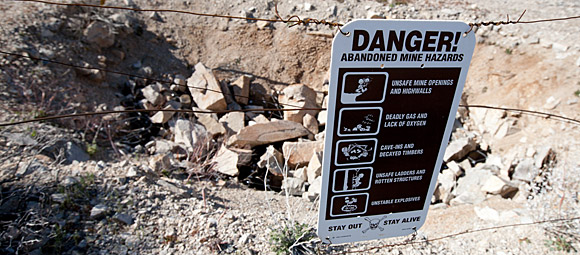
Eton Mine, Lucky Boy Trail, Joshua Tree National Park, California, USA.
[One in a series of posts from my spring 2011 trip to the southern California desert.]
Joshua Tree National Park is beautiful, but much of its history (prior to being designated a National Park) has scarred and pockmarked its landscape. In the Gold Rush, the Joshua Tree hinterlands held some of the most productive mines in California until well into the 1900’s. These mines were big, sprawling, and deep. To my knowledge, no Balrogs were released as a result. But that would explain a lot about Golden State politics.
We hiked on some lesser-traveled trails and found an acre of land with no fewer than five vertical holes in the ground: Mine shafts. They were all wired off and had metal grates over them. One in particular, the Eton Mine on the Lucky Boy trail, had warning signs on the wire fence surrounding it.
It was quite windy that day, and I just knew I had to get the creaking, squeaking sounds of this battered sign on the rusty wire. It took me a surprisingly long time to figure out how to protect my handheld recorder from the wind, but ultimately I decided to use my body as a shield and then stick it under my microfleece hoody. (I had the OEM fuzzy windscreen on it, which is one of the most useless strips of fabric I’ve ever seen, er, heard.) I just hoped that my body protected it from the 25+ mph wind gusts and that the fabric wouldn’t dampen the high frequencies too badly…and because of the sound, I had high-frequency content to burn.
With some judicious noise reduction in post – subtle, as always, gives the best result – it didn’t come out too shabby, considering the horrible recording conditions and super-no-budget wind blocking techniques!
[soundcloud url=”http://api.soundcloud.com/tracks/15163504″ params=”show_comments=true&auto_play=false&color=ee0000″ width=”100%” height=”81″ ]
[Sony PCM-D50 recorder, capsules at 120°]
Tags: creepy, desert, digital audio, eerie, field recording, found object, industrial, joshua tree, metal, resonance, sound design, sound effects, travel | 1 Comment »
Posted: May 4th, 2011 | Author: Nathan | Filed under: field recording, found sound objects, sound design

"Ol' Wheezy" the Water Spigot, as we called him, at our campground in the desert.
[One in a series of posts from my spring 2011 trip to the southern California desert.]
Joshua Tree National Park is in the Mojave Desert. It’s dry. Only two campgrounds in the entire park have running water of any kind. Bad weather on the coast of California caused us to decide to stay in the desert at the tail end of a week’s vacation, so we were lucky to just show up at Joshua Tree and grab a spot at one of these prime campgrounds.
I camp a lot, all over the place, but I had never seen a water spigot quite like the one near our site. It was like the wet dream of a post-apocalytpic film production designer: Big, industrial, heavy, and red. If a common water pump could be bad ass, this one could.
Anyway, the draw-up of water sounded really neat, so I whipped out the ol’ handheld recorder and took some samples on our last morning there. It reminded me a bit of the sound of EVE coming out of her landing ship’s tube from the film WALL•E.
In developed campgrounds, you need to be up really early to avoid noise from fellow campers. No wonder I like backpacking so much…
[soundcloud url=”http://api.soundcloud.com/tracks/13996448″ params=”show_comments=true&auto_play=false&color=ee0000″ width=”100%” height=”81″ ]
[Sony PCM-D50 recorder, capsules at 120°]
Tags: desert, digital audio, field recording, industrial, joshua tree, machine, sound design, sound effects, travel, whoosh | 6 Comments »
Posted: April 25th, 2011 | Author: Nathan | Filed under: field recording, nature recording
[One in a series of posts from my spring 2011 trip to the southern California desert.]
Anza Borrego Desert State Park is the second largest state park in the lower 48 United States. It’s dry, as its name implies, but it’s very seismically active and has many natural hot springs and oases scattered throughout the park, so water is less scarce than you’d think.
Even so, it shocked me almost beyond belief how filled some of these hot seeps were with frogs, and how loud they got at night. Sadly, I didn’t get any pictures of these tiny thumb-sized frogs, puffing out their chins to impress their ladyfriends, but I watched them for an hour with my headlamp while I recorded them from several perspectives. (Tip: Get a headlamp with a red LED or filter. This goes a long way in preserving your night vision while still illuminating nearby things like field recorder controls, and tends to spook animals less.)
Here is one long take from this session. It starts with distant frogs, one slow croaker nearby, and then gets really hopping (ugh, sorry, I had to do it) around 1 minute in. Then, after two and a half minutes, it dies down as quickly as it started.
[soundcloud url=”http://api.soundcloud.com/tracks/13996065″ params=”show_comments=true&auto_play=false&color=ee0000″ width=”100%” height=”81″ ]
[Sony PCM-D50 recorder, capsules at 120°]
Tags: desert, digital audio, field recording, frog, joshua tree, nature, nature recording, sound design, sound effects, travel | 5 Comments »
Posted: December 20th, 2010 | Author: Nathan | Filed under: found sound objects, sound design
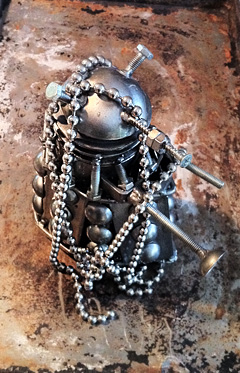
Exterminate! Exterminate!
In North America, the end of the Western calendar year brings Thanksgiving, Hanukkah, Kwanza, Christmas…lots of holidays, most of which revolve around eating. In our household, that means one thing above all else: PIE SEASON.
My wife loves making pies and tarts, and one of the baker’s secret weapons for such endeavors are pie weights. They’re simply large, heavy versions of the more common metal-ball-style keychain. Ours is about four feet in length.
While washing dishes after a piemaking bonanza, I noticed the sound it made as I dragged it over the lip of our stainless steel sink. Finally, on a rainy winter day, I decided to do some recording and processing.
I grabbed three things for this session: The pie weights, a really beat-up baking sheet, and a small model of a Dalek made from spare parts (a gift from a dear friend). I simply moved the pie weights across each of these objects in different ways. Hot metal-on-metal action!
The balls on the pie weights made a great ratcheting sound that instantly made me think of a castle portcullis being raised and lowered, or a ship’s winch retracting an anchor. Of course, the size of these weights made pretty bright sounds, but that’s what pitch shifting is for…
So, today’s sound is a mix of these sounds, some raw, and some pitched down significantly. I didn’t do anything besides pitch shifting and EQ, just to show how flexible these high-frequency, detailed sounds can be when recorded at 192kHz. These sounds were recorded with a large-diaphragm condenser mic, because I found that proximity effect from close-miking with a small-diaphragm condenser produced too much bass to provide the balanced, bright sounds that I was going after.
[soundcloud url=”http://api.soundcloud.com/tracks/8225412″ params=”show_comments=true&auto_play=false&color=ff7700″ width=”100%” height=”81″ ]
[Røde NT1a microphone into Sound Devices 702 recorder]
Tags: dalek, digital audio, field recording, industrial, machine, metal, pie, sound design, sound effects | 5 Comments »
Posted: November 16th, 2010 | Author: Nathan | Filed under: field recording, found sound objects

Home of the ceiling fan in question, and the weirdness that followed.
When in Mexico two years ago, the villa in which I stayed had a ceiling fan with very different voices when set to low and high. I’ve included a short sample of this fan at low, sounding like a grinding motor, and high, when the motor when silent but the blades sounded like a small helicopter.
Weirder than this sound was the villa, which was huge and beautiful, and overlooked the beach and the Pacific Ocean. It was surrounded by a river choked with human filth. Then the Dallas Cowboy Cheerleaders showed up. Then I thought I would die from food poisoning. All in one day.
True story. Tell you more over a beer sometime. Sorry, no cheerleader sounds were recorded.
[soundcloud url=”http://api.soundcloud.com/tracks/7100811″ params=”show_comments=true&auto_play=false&color=ee0000″ width=”100%” height=”81″ ]
[Zoom H2 recorder]
Tags: digital audio, field recording, found object, Mexico, sound design, sound effects, travel | 4 Comments »




